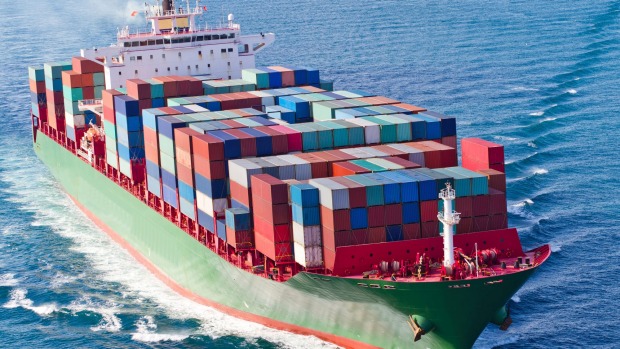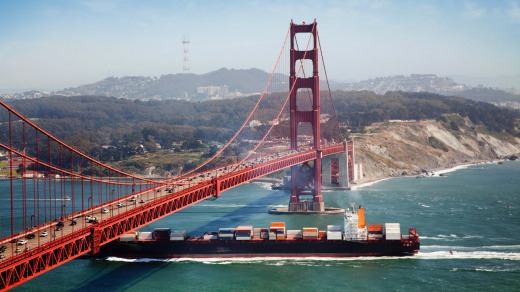
From tumultuous oceans to raw steak dinners, John McGuffick has had a few hairy moments at sea. But the retired Australian farmer says there's no better way to see the world than from a budget berth on a cargo ship.
McGuffick, 72, took his maiden voyage on a freighter in 1998 and hasn't stopped holidaying on them since. He's notched up thousands of kilomtres at sea, criss-crossing the globe on trips such as Southampton to Gothenburg, Philadelphia to Brisbane and Dunkirk to Singapore.
He recommends first-time cargo-ship travellers to spend time watching and observing before getting up close and personal with the crew and their equipment.

While crews are generally friendly, McGuffick recalls once being dressed down by a young Polish captain for almost delaying the boat's departure after a trip to shore. Another time, when he was on deck near the Malaysian coast, McGuffick was rebuked for using his camera flash to capture the rising sun—startling the captain, who was trying to avoid gas pipelines.
"Once they get to know you and you know them," he says of the crew, "you can have a look at the charts. If they want to use them, well, you step out of the way."
The ship's cook can make or break a trip. While food served from the galley can sometimes be bland,McGuffick says he's enjoyed some great meals. Much depends on the nationality of the crew: One chef was happy to indulge his German captain's love of raw minced steak drizzled with a cracked egg,McGuffick recalls.
"I've had some magnificent meals that you wouldn't even get on passenger ships," says McGuffick, who reared sheep and cattle and now lives in Cooma, New South Wales state. "One Filipino chef made crepes the size of dinner plates and stacked a foot high."
While container ships may be among the world's biggest vessels, they can still struggle in bad weather.
A few days out of Auckland, violent seas rocked one fully laden vessel McGuffick was travelling on, leaning it 33 degrees one way and almost as much in the other direction—an experience he describes as "hellish."
A routine call five years ago to the South Korean port of Masan, when McGuffick's ship was on the way from Singapore to Shanghai, turned into a sleepless night. Caught in a typhoon, the ship couldn't anchor in port; the only safe option was to sail beyond the harbor wall and ride out the weather.
It was a "scary one," McGuffick says. "She was on the move all night, doing figure eights."
In almost two decades at sea, one of McGuffick's most- treasured memories is of entering San Francisco harbour and passing under the Golden Gate Bridge.
"It was a magnificent sight," he says. "Clear sky and illuminated. It was fantastic."
Want to see the world without spending a fortune on a luxury cruise? Just be ready to make a few allowances once you step on the slow boat to China. Here's what you need to bring:
1. Satellite Modem
Striking terror into the heart of every teenager, Internet access is often slow or non-existent. You may be able to pay for a temporary account via the ship's satellite communications system, but if you really must update your blog frequently (Day 93 and the last Hershey bar is gone) you should probably bring your own portable satellite data link. Of course, one reason to come on board in the first place maybe to escape the grid.
2. War and Peace
Load up your tablet—it's going to be a long ride. There's no casino, cabaret or cocktail lounge here. Entertainment facilities tend to be limited on a working vessel, so unless you plan to become an Olympic table-tennis player, download plenty of books and movies to while away the days and nights when there's nothing to see but sea.
3. A Bicycle
When you do get to port, you're not going to arrive in the city center. Most container terminals are miles from town and you'll need to hitch a ride or find a taxi unless you want to spend precious shore time looking at more boxes. One solution is to bring your own bicycle. Just make sure you know how to get back to the ship on time. It probably isn't going to wait for you.
4. Tagalog for Dummies
The world's merchant vessels employ staff from dozens of nationalities and with passengers mixing with crew for meals and leisure, it's a chance to learn about other cultures. While most speak at least some English, bring a pocket translator to swap phrases with your Bulgarian cook or Indian engineer. Or maybe learn Tagalog, the main language of the Philippines. Filipinos make up about a third of officers in the global merchant fleet and around three quarters of ratings, according to a 2011 Deloitte report. The nation that's actually running global trade turns out to be an archipelago in Southeast Asia.
5. Running Shoes
There's nothing like an early morning run by the ocean watching the sunrise. All the better if you're in the ocean. Most vessels will allow you to access working parts of the ship with proper shoes and that means a lot of track. The biggest container vessels are as long as four football fields and have enough decks for you to run up or down more than 100 steps. Remember to stick to the safety rules though. This probably isn't the place to practice your parkour.
Bloomberg
See also: Cruising season 2015/16: Everything you need to know